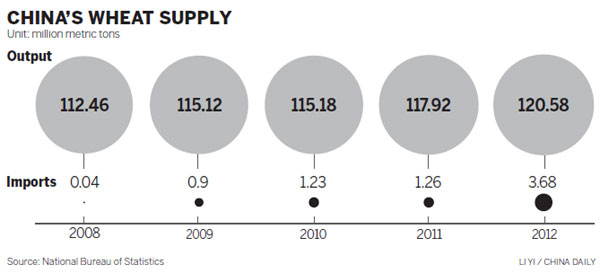|
There hasn't been much snow in winter wheat-producing regions of China over the past three-and-a-half months, and rainfall has only been about average. Still, the nation's imports aren't set to change much this year, industry experts said.
Winter wheat in China is usually planted between September and November, and harvested in the summer or early autumn of the following year.
The winter crop accounts for more than 90 percent of China's total wheat output.
The nation's main winter wheat-producing provinces include the provinces of Hebei, Shandong, Jiangsu, Anhui and Henan - all on the North China Plain - which account for 70 percent of total winter wheat production.
Other prime growing areas are Jiangsu and Anhui provinces in the Yangtze and Huaihe river valleys, respectively.
Total precipitation has been light in all of these areas this winter, according to the State Flood Control and Drought Relief Headquarters.
Ding Lixin, a researcher at the Chinese Academy of Agricultural Sciences in Beijing, said that current conditions in the North China Plain wouldn't harm the country's wheat output this year.
"After grappling with various extreme weather conditions for decades, China has implemented a number of measures.
"These include increasing supplementary irrigation facilities to compensate for the negative impact of [water shortages] to keep the staple food supply and demand in balance.
"The nation also provides timely allocations to support farmers' incomes and subsidize the costs of diesel, fertilizer and pesticide," said Ding.
To reduce the damage caused by drought in parts of the spring wheat-planting areas, China enlarged winter wheat production areas in the North China Plain and the Xinjiang Uygur autonomous region, among other steps.
Purchase price
The central government has also raised the floor purchase price for wheat to 2,360 yuan ($390) per metric ton this year, from 2,240 yuan in 2013, which is intended to spur farm output.
Major wheat-producing provinces such as Shandong and Henan have invested in new irrigation projects.
Those provinces also offered subsidies and other support to farmers to get them to switch from growing high-yield crops on 710,000 hectares of arable land and plant wheat instead.
The United States Department of Agriculture estimates China's wheat output will hit 122 million metric tons in the 2013-14 crop year (June-May), up about 1 percent from the previous crop year.
The wheat area has remained remarkably stable for the past five years at 24.1 million to 24.3 million hectares.
However, the market perspective for wheat output in the US remains challenging. Freezing temperatures are threatening US winter wheat crops, which has aroused concerns about international wheat prices.
Abdolreza Abbassian, a senior economist at the Food and Agriculture Organization of the United Nations, said it is too early to predict the outcome of wheat harvests in 2014. However, based on current conditions, the overall prospects are favorable, and world supplies are likely to be "abundant" in 2014.
Hu Zengmin, an analyst with the China National Grain and Oils Information Center, said that an adequate increase in wheat imports will be useful in helping China ease the pressure on flour and wheat-related food prices.
"The possible output reduction in US wheat this year may further diversify China's wheat import channels from other parts of the world," Hu said.
"Wheat imported from Russia, Ukraine, Australia and France also costs much less than wheat produced in China, based on current market prices."
CNGOIC forecast that China will import 6.5 million metric tons of wheat in 2014.
zhongnan@chinadaily.com.cn

|